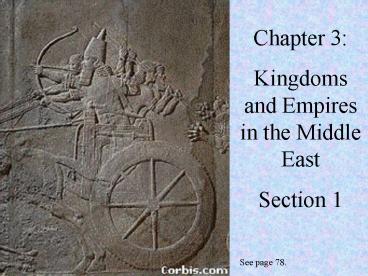Kingdoms and Empires in the Middle East - PowerPoint PPT Presentation
1 / 12
Title:
Kingdoms and Empires in the Middle East
Description:
Title: No Slide Title Author: Instructional ATI Last modified by: workshop Created Date: 8/14/2000 3:23:14 PM Document presentation format: On-screen Show – PowerPoint PPT presentation
Number of Views:258
Avg rating:3.0/5.0
Title: Kingdoms and Empires in the Middle East
1
Chapter 3 Kingdoms and Empires in the Middle
East Section 1
See page 78.
2
The peoples of Mesopotamia and Egypt influenced
others around them in the Fertile Crecent with
trade. Among these trading partners were the
Aramaeans and the Phoenicians.
3
The Aramaeans settled central Syria around 1200
BC with a capital at Damascus. Due to their
extensive trading by ship, many people learned to
speak Aramaic (closely related to Hebrew and
Arabic). In fact, Jesus spoke Aramaic and some
parts of the Bible were written in Aramaic.
4
The Phoenicians lived between Egypt and Syria in
what is now Lebanon, Israel, and Jordan. They
were a Semitic group that migrated from the
Arabian Peninsula about 3000 BC. Some traded
through caravans ship. Their southern
neighbors were the Philistines.
5
(No Transcript)
6
The Phoenicians introduced new trade concepts to
their neighbors such as Bills of Sale and
Contracts. But their most important advantage
was the use of a 22 character alphabet to keep
track of inventory and transactions.
7
(No Transcript)
8
They established city-states. The largest was
Tyre, leading a confederation (a loose
association of cities). They also established
coastal trading colonies. One example is
Carthage, which eventually became the most
wealthy city in the Mediterranean.
9
Yellow Arrow Phoenicians Red
Arrow Carthage Green
Arrow Lydians
10
The Lydians lived in what is now Turkey, between
the Mediterranean, Aegean, and Black Seas. They
developed a system of trade that used metal coins
that represented an arbitrary value (money).
X 2
11
These civilizations were polytheistic, believing
in many gods.
12
This whole process of influencing others by trade
or contact is called Cultural Diffusion.































